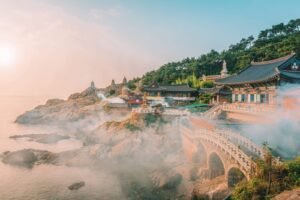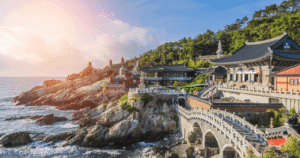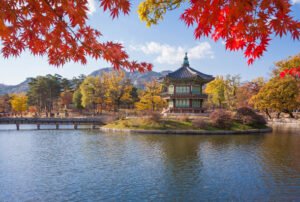


When I first set foot in Seoul, I could sense the tension between gleaming skyscrapers and ancient alleyways, between ultramodern metro cars and whispering Buddhist temples tucked behind city hillsides. In my months traveling across the peninsula, I sought out hidden places to visit in South Korea — the places that don’t dominate glossy postcards or Instagram feeds, yet hold the deepest stories. These hidden places to visit in South Korea are where you feel time fold, where the past lingers in stone and forest, and where the present presses close in surprising juxtaposition.
In this journey through Korea’s lesser-seen corners, we will walk through old caves, secret islands, forgotten villages, and unheralded cultural enclaves. Each place is a layer: some visible, some buried, some recovered. My hope is that this article not only inspires visits but serves as a resource for further study and research into the palimpsest that is South Korea’s geography of memory.
Why Hidden Places Matter
We often visit the grand palaces, the famous museums, the branded “must-see” spots. But hidden places tell a richer story — they reveal what mainstream narratives ignore: local memory, marginal histories, the quiet interplay of nature and culture. To visit hidden places is to peel back the veneer of a national image and sense how ordinary people in different eras lived, prayed, rebelled, and rebuilt.
Moreover, hidden places to visit in South Korea often live at the intersection of ecology and heritage — caves, coastal rocks, islands, forest shrines — and thus provide fertile ground for multidisciplinary study (history, archaeology, environment, anthropology). In exploring them, you’ll see how Korea’s rapid modernization jostles with its centuries-old traditions.
In the following sections, I organize by region (Greater Seoul, Central & Eastern, Southern & Islands) and within each present a handful of hidden gems, with stories, access notes, and research leads.
Greater Seoul and Surroundings
Although Seoul is a global metropolis, even here layers of past and present hide in overlooked alleys, mountain foothills, and redeveloped industrial spaces.
Ikseon-dong Hanok Village: Secret Canals of Memory
Tucked near Jongno, Ikseon-dong Hanok Village is often overshadowed by Bukchon, but it is one of the best hidden places to visit in South Korea for experiencing how modern cafés and boutique shops mingle with old Korean courtyard homes (hanok). Local guides note that you can wander small alleys where lanterns hang overhead while children draw chalk on stone paving. The district’s small workshops, tea houses, and narrow lanes feel like a preserved memory in the heart of a city pushing upward. GoNomad+1
For deeper study, look into how ikseon-dong’s redevelopment (post‐2000s) has become a model in heritage conservation, balancing commerce and authenticity.
Gwangmyeong Cave — Mine, Memory, and Showrooms
Not far southwest of central Seoul lies Gwangmyeong Cave, a repurposed mine turned multimedia tourist site. Once a gold and pyrite mine developed during the Japanese colonial period, then used as storage and salt curing facilities, it reopened in 2011 as a subterranean theme complex with exhibits, light shows, aquariums, and even a winery in tunnels stretching some 7.8 km. Wikipedia
Walking its dimly lit corridors, visitors confront a layered timeline: colonial labor, mid-20th century industrial change, and present-day spectacle. Scholars of memory studies and postcolonial infrastructure often use Gwangmyeong as a case study in how industrial ruins are reimagined for tourism.
Access tip: Go in late afternoon to see the changing light installations, and combine it with visits to nearby towns in Gyeonggi Province.
Samcheonggak: A Presidial Escape and Forested Retreat
Hidden high in the hills behind the presidential Blue House in Seoul, Samcheonggak is a small traditional-style retreat set amidst forest. It was created in 1972 under the Park Chung-hee regime as an entertainment venue (a kind of elevated kisaeng house) for VIP visitors. Wikipedia
Walking there, you feel the hush of pine trees, the drip of hillside streams, the quiet of ritualized architecture. It’s a place where the state once mingled with art, politics, and tradition. For research, one might explore how elite patronage shaped its design, how it has been reimagined in democratic Korea, and how it intersects with public reception to “hidden” official spaces.
Central & Eastern Korea: Caves, Cliffs, and Quiet Villages
Beyond Seoul’s orbit, the Korean peninsula reveals a rawer tapestry: coastal cliffs, mountain caves, and remote villages that preserve older ways of life.
Seongnyugul Cave: Sacred Refuge in a Limestone Fold
In Uljin, North Gyeongsang Province, Seongnyugul Cave (also Seonyugul) is a fascinating fusion of geology and history. Recognized as Natural Monument 155 since 1963, its main hall is about 330 m long, with side passages reaching ~540 m, and an interior lake formed by water flowing from the nearby Wangpicheon River. Wikipedia
Historically, it is said that in the 1592 Japanese invasion, about 500 people took refuge inside and were blocked in, perishing when forces sealed the entrance. Its name, meaning a place where sacred Buddhas stayed, suggests spiritual usage. The cavern also appears in paintings, travelogues, and poems from multiple dynasties. Wikipedia
Visiting, you will descend wooden walkways, view fascinating karst formations, feel echoes of vulnerability, and imagine how people once hid behind the rock. For further study: compare the cave’s layered mythic history with local folk memory, and consider hydrological studies of cave-river interaction.
The Jindo Sea Parting (Miracle of Moses): A Buried Road Revealed
One of South Korea’s most enchanting phenomena is the Jindo Sea Parting (or “Miracle of Moses”), when the tide recedes to reveal a 2.8 km natural land bridge between Jindo Island and Modo Island. The event occurs only a few times each year, and draws crowds eager to walk across the ocean floor. The Times of India
At those moments, you feel the sea’s hidden architecture revealed, and the living memory of coastal communities who once interpreted it as divine intervention. Scholars of folklore, geology, or ritual tourism might examine how this event persists culturally in local festivals, oral histories, and modern tourism design.
Visiting tip: Check tide schedules well in advance (often announced by local authorities), go with guides, and remain aware of time — the path vanishes again as the tide returns.
Daepo Jusangjeolli Cliffs: Basalt Columns at Jeju’s Edge
On the southern coast of Jeju Island, at Seogwipo, lies Daepo Jusangjeolli Cliff — dramatic columnar basalt formations created when volcanic lava cooled against the sea. The 20 m high geometric cliffs have become a scenic spot, less advertised than Jeju’s other tourist draws. Wikipedia
Walking the cliff promenade, you feel the rupture between earth and ocean, between molten past and quiet present. Combine it with nearby hidden coves, less-traveled beach paths, or walks through Jeju’s quiet villages.
For deeper research, look into the island’s volcanic geology (Hallasan’s eruptions) and how Jeju’s local identity has been repositioned in modern tourism beyond mainstream K-travel circuits.
Wolseong (Banwolseong): Crescent Palace Ruins in Gyeongju
In Gyeongju, the ancient capital of the Silla kingdom, lies Wolseong (also Banwolseong), or the “Moon Castle.” Once the royal palace, its name refers to its crescent-shaped fortress walls. Today, the ruins lie amid forested hills, with stone foundations, moats, and overgrowth. Wikipedia
Walking through this site, you sense what is lost and what is remembered: foundations of kingly halls, trees reclaiming walls, fragments of stone, and the still presence of royal ambition. Gyeongju itself is rich with layered heritage, so weaving a visit to Wolseong with nearby tombs, temples, and museums offers a living map of Korea’s premodern past.
If you like, you can contrast Gyeongju’s high-profile heritage (Bulguksa, Seokguram) with these quieter ruins to understand how UNESCO designation interacts with local memory.
Southern Korea & Coastal Islands
The southern peninsulas and islands of Korea open to sea, wind, and more secluded cultural forms — hidden villages, small islands, temple cliffs, and salt-practicing communities.
Ganghwa and Seokmo Islands: Dolmens, Fortresses, and Quiet Shores
West of Seoul, in the waters near Incheon, are the Ganghwa Do and nearby Seokmo Islands. They are often neglected by international tourists but offer enigmatic dolmen clusters (megalithic tombs), quiet shorelines, and old fortifications. Travel Is Zen
Walking their roads, you sense a coastal memory slower than Korea’s push eastward. For historians, they are also sites of border contestation, trade, and cultural exchange. If you search off-season, you may find deserted paths, oyster farms, and fishing villages largely untouched by mass tourism.
Haedong Yonggungsa: A Sea-Side Temple in Busan
While many know Busan’s big beaches, fewer venture to Haedong Yonggungsa, a temple set on a coastal cliff overlooking the East Sea. Built in 1376 during the Goryeo Dynasty and restored in 1930, its rare seaside location (temples are often inland) gives it a unique resonance. TheCollector
Visiting at sunrise, you’ll watch waves crash beneath lantern-lit stairways and hear wind echo through red pillars. It’s a meeting point of sea and spirit — and a reminder that the sacred in Korea is not only in the mountains. This would be a worthy subject for those studying coastal Buddhism and how geography shapes ritual placement.
Jangsaengpo Whale Museum, Ulsan: Memory of Whaling
In Ulsan, Jangsaengpo Whale Museum stands on former whaling grounds and is the only whale museum in South Korea. It presents artifacts, photographs, and narratives surrounding Korea’s whaling history (whaling was banned in 1986). Wikipedia
Entering the museum, you sense the ghosts of sea hunts, shifting ecological policy, and local community memory. A research angle lies in maritime conservation, shifting national identity, and how museum narratives mediate controversial legacies.
Tips for Visiting Hidden Places
Here are practical suggestions to get the most from your journey in search of hidden places to visit in South Korea:
-
Go off-season or early/late in the day. Many hidden spots see few visitors outside summer weekends.
-
Engage local guides or community tourism. Some places have no signposts; locals can guide you safely.
-
Combine with larger nodes. Use Gyeongju or Jeju as bases from which to branch out.
-
Check access: roads, trails, tides. Caves or sea paths may require permits or timing.
-
Respect local memory. Some places are sacred, fragile, or socially sensitive.
-
Document and compare. Take notes, photographs, and record stories — these places are constantly in flux with development pressures.
Hidden Places in South Korea and Comparative Travel
If you enjoy exploring the hidden places to visit in South Korea, you might also find delight in uncovering lesser-known gems in other countries. For instance, when traveling in Africa, you can see how national narratives and hidden corners interact — for example, in Kenya. If you’re curious, check out my earlier guide: The Best Places to Visit in Kenya (internal link) — [https://jetsettrail.com/the-best-places-to-visit-in-kenya/] — and see how hidden, quiet places reshape travel stories.
Reflections: Layers of Past and Present
As I visited each site, I found recurring motifs:
-
Palimpsest landscapes: The same rock, temple, or village often bears traces from multiple eras — Silla stones beneath Joseon walls under modern signage.
-
Memory contested: Some hidden places survive because official heritage omitted them; others were reclaimed or sanitized.
-
Ecological entanglement: Many hidden places are in caves, cliffs, sea paths, or forest margins — nature and culture inseparable.
-
Tourism friction: The very act of making a place “discoverable” changes it; hidden places are fragile to visitor influx.
For researchers, these places offer living laboratories. One might map networks of hidden temple refuges; compare oral histories to archaeological records; or examine how modernization narratives purge or incorporate such hidden sites.
As modern South Korea strides ahead — skyscrapers, high-speed train corridors, gleaming malls — these hidden places anchor the story. They are the margins, the whispers, the small tokens that tether past to present.
Even if you never visit all of them, knowing about these hidden places to visit in South Korea invites you to travel differently — to pause, sense, question, and see layers rather than surfaces. May your next trip bring you into quiet alleys, subterranean caves, mist-hung cliffs, and seas parted by miracles.
Suggested Further Reading & Links
-
Off the Beaten Path in South Korea — Travel Is Zen’s essays and itineraries on lesser-known places Travel Is Zen
-
109 Cool and Unusual Things to Do in South Korea — An Atlas Obscura list of hidden oddities Atlas Obscura
-
Guide to the Best Historic Sites in South Korea — summary of major and minor heritage locations TheCollector


